My Italian Home: 'How we renovated an apartment in a historic Bologna palazzo'
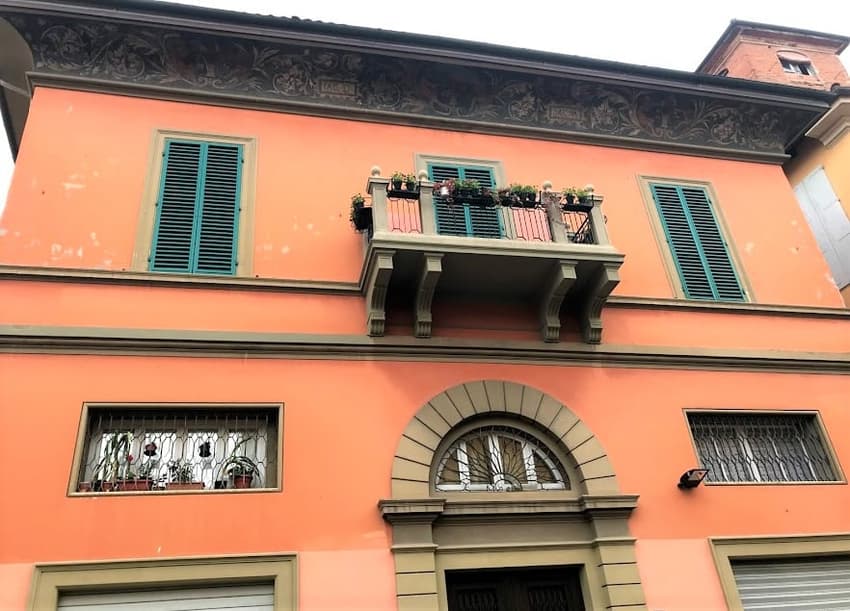
One reader from the US tells us how she and her husband found their apartment in Bologna's historic center, and made a few small updates... and then a few more.
When Nicole Paolini-Subramanya and her husband, who currently live in Brooklyn, New York, decided they wanted to retire in Italy, the city of Bologna held far more appeal than the Italian countryside.
“I lived in Bologna for two years in the early 1990s, and absolutely loved everything about the city. It's a vibrant and culturally rich university town,” Nicole says. “We have both lived in large cities most of our lives, so unlike a lot of expats, we weren't interested in the countryside.”
READ ALSO: My Italian Home: The ups and downs of buying a property for retirement in a hilltop village in Italy
Now in the final stages of renovating her new home in Bologna, she talks us through the process of finding, buying and then remodelling an apartment in a historic building, a process they've completed remotely while still living in Brooklyn.
How did you find the property?
"Once we decided that we were going to buy a place in Bologna, we started by searching all of the online real estate websites (immobiliare.it, casa.it, etc.).It took us almost a year to find anything that fit our criteria - we wanted a two-bedroom, two-bath apartment in a palazzo antico in the very center of the centro storico (historic center), and we had a budget.
Eventually, we put together a handful of interesting listings within our price range, contacted the agents, set up appointments, and flew to Bologna to see the apartments. But after viewing a few apartments that weren't quite right, walking the streets of Bologna and scanning adverts in real estate agencies' windows, we couldn't find anything that we liked.
We were discouraged, and out of ideas. We figured that we would probably need to put this fantasy aside for a while.
But a couple of days before our flight back to the States, a new listing popped up in the Ghetto Ebraico, a historic, central neighborhood. It was our dream location.
I called the agent for the apartment, and she rode right over on her bike to meet us at the palazzo, which was on a charming piazzetta (little square) with two restaurants and a wine bar across the street. The front of the palazzo was from the early 19th century, and had been added onto an older, 15th century building.
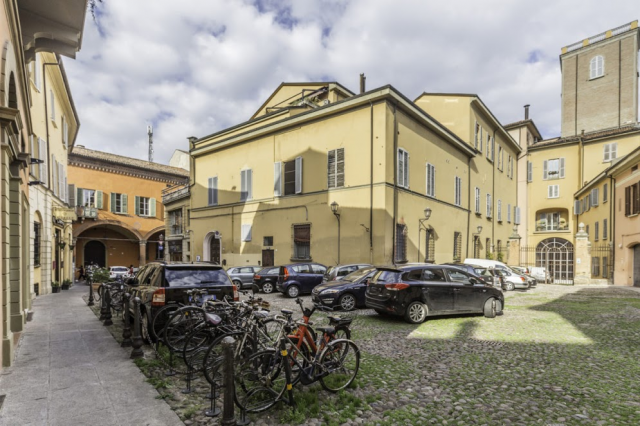
The square in Bologna's historic centre.
At a little over 70 square meters, the apartment was small and a bit dark, with only one bedroom and one bath, but it had an open soggiorno (living room), arched windows, the original wood-beamed ceiling, and a working fireplace. It had been professionally renovated about fifteen years before, so it was turn-key. It just felt right.
We turned to the agent and told her that we wanted to make an offer. By that evening, we were under contract
What was the buying process like?
We found the buying process to be very smooth, but it wasn't self-executing. We had to put in a bit of time and effort.
First, there were some minor (but time-consuming) administrative tasks. My husband didn't have a codice fiscale, and we didn't have an Italian checking account. We also needed to find a notaio (notary) to do the title search and draft all of the documentation.
Our agent recommended a notaio, but we were a little uncomfortable with using someone recommended by the agent. Instead, we found a notaio through a friend of a friend. In most places, you also need to find a geometra to inspect the property, but we were spared that task because Bologna requires the seller to retain a geometra to inspect and certify the property.
READ MORE:
Our notaio (who had come with glowing reviews) had everything done within a month, but the sellers wanted to retain possession for a couple of more months. When we finally closed, it was actually fun. Our notaio was right out of central casting - courtly and charming, with an elegantly-tailored suit, a head of luxurious gray hair, and a grand sense of ceremony.
He read through all the documents line by line in a deliberate, melodious baritone so that my husband and I could understand everything.
We were happy, the sellers were happy, our agent was happy... it felt almost like a wedding. Like we were marrying Italy.
How are the renovations going?
Our major issue was caused by a muro grosso, a "big" wall between the bathroom and the living area.
When we bought our apartment, we didn't plan to renovate. But (as you probably know), in Italy, the sellers take the kitchens with them unless you arrange otherwise. The kitchen in our apartment was fifteen years old, so we were happy enough to wave goodbye and find something new.
Then I said to my husband "well, as long as we are buying a new kitchen, maybe we should redo those ceramic floors - they are making a dark place even darker." My husband then suggested that, as long as we were ripping up the floors, we should probably take the opportunity to put in a guest bathroom.
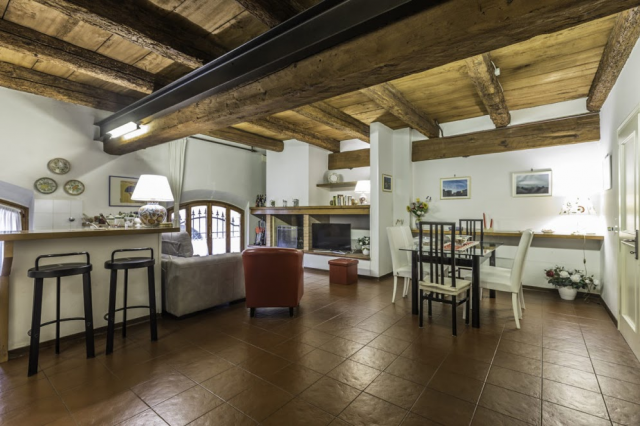
The soggiorno before renovation work began.
And why not move the kitchen while we're at it?
To make a long story short, we'd soon decided to gut the apartment.
Our agent put us in touch with an architect, Annagrazia. Annagrazia went to see our apartment and emailed me with some ideas, and included some pictures of her other renovations. She could do the day-to-day construction management. We could monitor the process remotely from the States through smartphones and email. We had an architect!
Over the next couple of weeks, Annagrazia came up with some initial plans. The existing bathroom was awkwardly located, and blocked off half of one of our beloved arched windows. We were desperate to move it, and to add that half-bath.
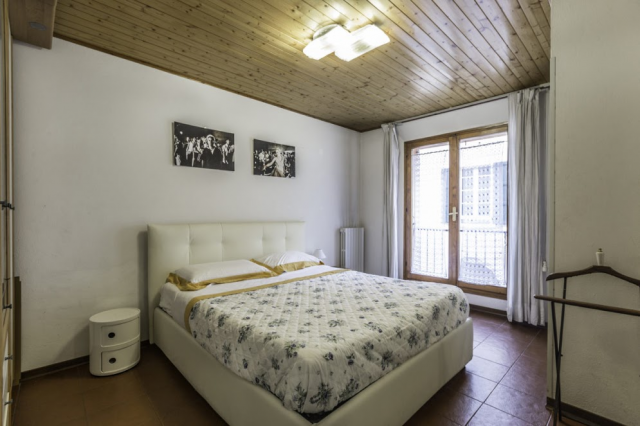
But to move the bathroom, we'd need to knock down the muro grosso between the bathroom and the soggiorno. The bathroom was obviously a fairly recent addition to the 15th century portion of the apartment, so that wall couldn't actually be structural, right?
To find out, Annagrazia had the muratore (bricklayer) break through the plaster to expose the innards of the wall. The engineer came to inspect. Given the substantial brickwork inside the wall, he couldn't say that it wasn't structural.
Worse, he would need the comune to approve the removal of the wall. To get that approval, he'd need to put together a structural report. To do that, he'd need to go into the units above and below us to survey the structure. Not all of the neighbours were happy with this.
But Annagrazia oversaw the whole operation, charmed the neighbour, Signora X, into letting the engineer access their storage space, and kept working on the plans. Four months later, the engineer was able to inspect.
I don't know if we had dumb luck or if this is the Italian norm, but we clicked with our architect right away, and she and her team have been a dream to work with. They are all talented, knowledgeable, professional, and tirelessly hard-working.
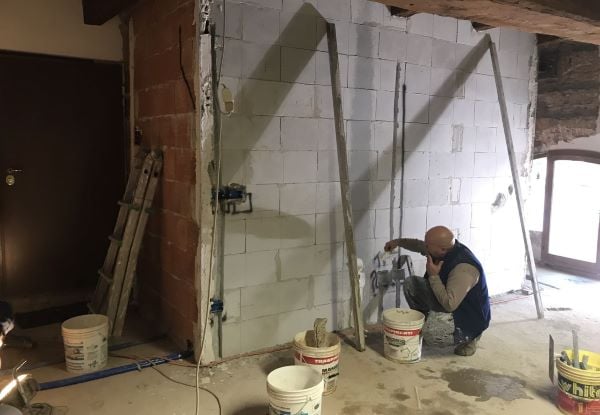
The apartment has had new plumbing, new wiring, new interior walls and a new subfloor. The bathrooms will be finished by mid-January. After our frighteningly expensive custom windows are installed, the paving contractor will install our herringbone floors, and the marmista (marble worker) and falegname (carpenter) will install our kitchen and bedroom cabinetry.
We are expecting the apartment to be done by the end of March 2020 – a year from closing. The whole process took 16 months in total.
We are now looking forward to living in our apartment for several months at a time, with trips home to the States in between.
The biggest lessons we learned:
1. If you have a good architect or geometra, it is not difficult to renovate remotely.
2. Try to remember that your renovation is disruptive to your neighbors. They have to live with the noise, the dust, and the dumpster in the street. So hire professionals who will maintain an orderly construction site. Our neighbors were much more open to our renovations because Annagrazia's team had done work in the building before, and the neighbors knew that they were skilled and would keep the public areas free of debris.
3. That said...if you buy an apartment (as opposed to a single family home), your neighbors will have some degree of control over your renovations.
4. Old buildings often have surprises. Our apartment was thoroughly inspected, but while pulling up floors and pulling down plaster, our workers uncovered a void in the subfloor under the existing shower, and cracks in the outside wall that we needed to stabilize with steel bands (cha-ching). When we removed the drop ceiling in the bedroom to expose the wood beams, we discovered why they had been covered in the previous renovation. There were large gaps in the assito, allowing one to lie in bed and leisurely contemplate the plastic moisture barrier under the paving of our upstairs neighbor. We're still trying to decide what to do about that ceiling.
5. You can't always get what you want. We really, really wanted marble bathrooms and the graniglie floors that are so characteristic of the region. But unless we gave up marble kitchen countertops, we couldn't have stone in the bathrooms because of load limitations in our 15th century palazzo. The fantastically heavy graniglie was a complete non-starter. Instead, we went with ceramic marmo finto (marble effect) for the bathrooms and walnut herringbone floors. We also had to give up the fireplace that had seemed so appealing when we first saw the apartment. It was a 1980s addition that took up a large corner of the small soggiorno, and it needed thousands of euros of updating. Under Bologna's environmental laws, we would only be able to use it a couple of days a year. It just didn't seem worth it (or green). Instead, we replaced it with a beautiful antique terracotta mantle.
6. Charming architecture can require expensive solutions. Because our quaint wooden windows were showing their age and were not energy-efficient, we had to have new windows fabricated to fit the arched window openings. The windows were the second most expensive line item in the renovation. Since our rooms were so small and had an irregular ceiling line (those wood beams), we resorted to custom-made cabinetry for the kitchen, bathrooms and bedroom. In retrospect, it may actually have been less expensive to buy a slightly larger place.
7. Darker spaces may require professional lighting design. Our soggiorno does not have much natural light, so our architect recommended a lighting designer. When the project is done, we are assured that our soggiorno will be brightly (but naturally) illuminated. But lighting does not come cheap.
8. Expect to go over-budget, and don't choose a project that stretches you financially. When we chose our place, we were blinded by the charm. It was so old! So cute! We didn't register any of the practical shortcomings. Working around those issues (and a visit to the stone warehouses in Verona) has sucked many, many euros from our Italian bank account. Fortunately, we anticipated our utter lack of preparedness, common sense and fiscal discipline, and we chose an apartment at the bottom end of our budget. So we've been able to roll with the financial punches and have a lot of fun with the whole adventure. It also helps that our architect is a saint and talks us down from any particularly ill-conceived choices.
9. There is a lot of coordination involved, and the project will take much longer than you think. Even if - like us - you have the world's most diligent architect and construction crew.
Have you bought and renovated a property in Italy? We'd love to hear about your experience. Get in touch and let us know if you'd like your own Italian home to be featured.
Comments
See Also
When Nicole Paolini-Subramanya and her husband, who currently live in Brooklyn, New York, decided they wanted to retire in Italy, the city of Bologna held far more appeal than the Italian countryside.
“I lived in Bologna for two years in the early 1990s, and absolutely loved everything about the city. It's a vibrant and culturally rich university town,” Nicole says. “We have both lived in large cities most of our lives, so unlike a lot of expats, we weren't interested in the countryside.”
READ ALSO: My Italian Home: The ups and downs of buying a property for retirement in a hilltop village in Italy
Now in the final stages of renovating her new home in Bologna, she talks us through the process of finding, buying and then remodelling an apartment in a historic building, a process they've completed remotely while still living in Brooklyn.
How did you find the property?
"Once we decided that we were going to buy a place in Bologna, we started by searching all of the online real estate websites (immobiliare.it, casa.it, etc.).It took us almost a year to find anything that fit our criteria - we wanted a two-bedroom, two-bath apartment in a palazzo antico in the very center of the centro storico (historic center), and we had a budget.
Eventually, we put together a handful of interesting listings within our price range, contacted the agents, set up appointments, and flew to Bologna to see the apartments. But after viewing a few apartments that weren't quite right, walking the streets of Bologna and scanning adverts in real estate agencies' windows, we couldn't find anything that we liked.
We were discouraged, and out of ideas. We figured that we would probably need to put this fantasy aside for a while.
But a couple of days before our flight back to the States, a new listing popped up in the Ghetto Ebraico, a historic, central neighborhood. It was our dream location.
I called the agent for the apartment, and she rode right over on her bike to meet us at the palazzo, which was on a charming piazzetta (little square) with two restaurants and a wine bar across the street. The front of the palazzo was from the early 19th century, and had been added onto an older, 15th century building.

The square in Bologna's historic centre.
At a little over 70 square meters, the apartment was small and a bit dark, with only one bedroom and one bath, but it had an open soggiorno (living room), arched windows, the original wood-beamed ceiling, and a working fireplace. It had been professionally renovated about fifteen years before, so it was turn-key. It just felt right.
We turned to the agent and told her that we wanted to make an offer. By that evening, we were under contract
What was the buying process like?
We found the buying process to be very smooth, but it wasn't self-executing. We had to put in a bit of time and effort.
First, there were some minor (but time-consuming) administrative tasks. My husband didn't have a codice fiscale, and we didn't have an Italian checking account. We also needed to find a notaio (notary) to do the title search and draft all of the documentation.
Our agent recommended a notaio, but we were a little uncomfortable with using someone recommended by the agent. Instead, we found a notaio through a friend of a friend. In most places, you also need to find a geometra to inspect the property, but we were spared that task because Bologna requires the seller to retain a geometra to inspect and certify the property.
READ MORE:
Our notaio (who had come with glowing reviews) had everything done within a month, but the sellers wanted to retain possession for a couple of more months. When we finally closed, it was actually fun. Our notaio was right out of central casting - courtly and charming, with an elegantly-tailored suit, a head of luxurious gray hair, and a grand sense of ceremony.
He read through all the documents line by line in a deliberate, melodious baritone so that my husband and I could understand everything.
We were happy, the sellers were happy, our agent was happy... it felt almost like a wedding. Like we were marrying Italy.
How are the renovations going?
Our major issue was caused by a muro grosso, a "big" wall between the bathroom and the living area.
When we bought our apartment, we didn't plan to renovate. But (as you probably know), in Italy, the sellers take the kitchens with them unless you arrange otherwise. The kitchen in our apartment was fifteen years old, so we were happy enough to wave goodbye and find something new.
Then I said to my husband "well, as long as we are buying a new kitchen, maybe we should redo those ceramic floors - they are making a dark place even darker." My husband then suggested that, as long as we were ripping up the floors, we should probably take the opportunity to put in a guest bathroom.

The soggiorno before renovation work began.
And why not move the kitchen while we're at it?
To make a long story short, we'd soon decided to gut the apartment.
Our agent put us in touch with an architect, Annagrazia. Annagrazia went to see our apartment and emailed me with some ideas, and included some pictures of her other renovations. She could do the day-to-day construction management. We could monitor the process remotely from the States through smartphones and email. We had an architect!
Over the next couple of weeks, Annagrazia came up with some initial plans. The existing bathroom was awkwardly located, and blocked off half of one of our beloved arched windows. We were desperate to move it, and to add that half-bath.

But to move the bathroom, we'd need to knock down the muro grosso between the bathroom and the soggiorno. The bathroom was obviously a fairly recent addition to the 15th century portion of the apartment, so that wall couldn't actually be structural, right?
To find out, Annagrazia had the muratore (bricklayer) break through the plaster to expose the innards of the wall. The engineer came to inspect. Given the substantial brickwork inside the wall, he couldn't say that it wasn't structural.
Worse, he would need the comune to approve the removal of the wall. To get that approval, he'd need to put together a structural report. To do that, he'd need to go into the units above and below us to survey the structure. Not all of the neighbours were happy with this.
But Annagrazia oversaw the whole operation, charmed the neighbour, Signora X, into letting the engineer access their storage space, and kept working on the plans. Four months later, the engineer was able to inspect.
I don't know if we had dumb luck or if this is the Italian norm, but we clicked with our architect right away, and she and her team have been a dream to work with. They are all talented, knowledgeable, professional, and tirelessly hard-working.

The apartment has had new plumbing, new wiring, new interior walls and a new subfloor. The bathrooms will be finished by mid-January. After our frighteningly expensive custom windows are installed, the paving contractor will install our herringbone floors, and the marmista (marble worker) and falegname (carpenter) will install our kitchen and bedroom cabinetry.
We are expecting the apartment to be done by the end of March 2020 – a year from closing. The whole process took 16 months in total.
We are now looking forward to living in our apartment for several months at a time, with trips home to the States in between.
The biggest lessons we learned:
1. If you have a good architect or geometra, it is not difficult to renovate remotely.
2. Try to remember that your renovation is disruptive to your neighbors. They have to live with the noise, the dust, and the dumpster in the street. So hire professionals who will maintain an orderly construction site. Our neighbors were much more open to our renovations because Annagrazia's team had done work in the building before, and the neighbors knew that they were skilled and would keep the public areas free of debris.
3. That said...if you buy an apartment (as opposed to a single family home), your neighbors will have some degree of control over your renovations.
4. Old buildings often have surprises. Our apartment was thoroughly inspected, but while pulling up floors and pulling down plaster, our workers uncovered a void in the subfloor under the existing shower, and cracks in the outside wall that we needed to stabilize with steel bands (cha-ching). When we removed the drop ceiling in the bedroom to expose the wood beams, we discovered why they had been covered in the previous renovation. There were large gaps in the assito, allowing one to lie in bed and leisurely contemplate the plastic moisture barrier under the paving of our upstairs neighbor. We're still trying to decide what to do about that ceiling.
5. You can't always get what you want. We really, really wanted marble bathrooms and the graniglie floors that are so characteristic of the region. But unless we gave up marble kitchen countertops, we couldn't have stone in the bathrooms because of load limitations in our 15th century palazzo. The fantastically heavy graniglie was a complete non-starter. Instead, we went with ceramic marmo finto (marble effect) for the bathrooms and walnut herringbone floors. We also had to give up the fireplace that had seemed so appealing when we first saw the apartment. It was a 1980s addition that took up a large corner of the small soggiorno, and it needed thousands of euros of updating. Under Bologna's environmental laws, we would only be able to use it a couple of days a year. It just didn't seem worth it (or green). Instead, we replaced it with a beautiful antique terracotta mantle.
6. Charming architecture can require expensive solutions. Because our quaint wooden windows were showing their age and were not energy-efficient, we had to have new windows fabricated to fit the arched window openings. The windows were the second most expensive line item in the renovation. Since our rooms were so small and had an irregular ceiling line (those wood beams), we resorted to custom-made cabinetry for the kitchen, bathrooms and bedroom. In retrospect, it may actually have been less expensive to buy a slightly larger place.
7. Darker spaces may require professional lighting design. Our soggiorno does not have much natural light, so our architect recommended a lighting designer. When the project is done, we are assured that our soggiorno will be brightly (but naturally) illuminated. But lighting does not come cheap.
8. Expect to go over-budget, and don't choose a project that stretches you financially. When we chose our place, we were blinded by the charm. It was so old! So cute! We didn't register any of the practical shortcomings. Working around those issues (and a visit to the stone warehouses in Verona) has sucked many, many euros from our Italian bank account. Fortunately, we anticipated our utter lack of preparedness, common sense and fiscal discipline, and we chose an apartment at the bottom end of our budget. So we've been able to roll with the financial punches and have a lot of fun with the whole adventure. It also helps that our architect is a saint and talks us down from any particularly ill-conceived choices.
9. There is a lot of coordination involved, and the project will take much longer than you think. Even if - like us - you have the world's most diligent architect and construction crew.
Have you bought and renovated a property in Italy? We'd love to hear about your experience. Get in touch and let us know if you'd like your own Italian home to be featured.
Join the conversation in our comments section below. Share your own views and experience and if you have a question or suggestion for our journalists then email us at [email protected].
Please keep comments civil, constructive and on topic – and make sure to read our terms of use before getting involved.
Please log in here to leave a comment.